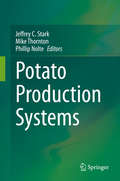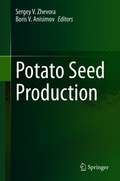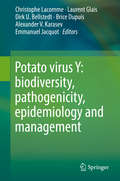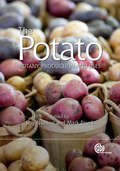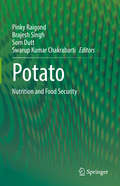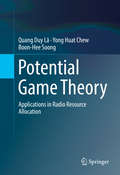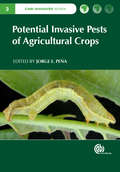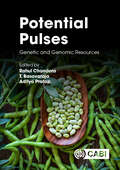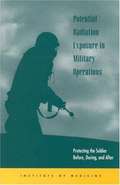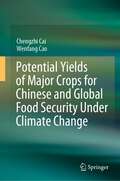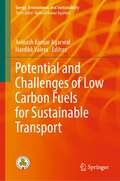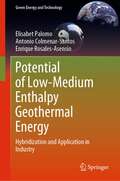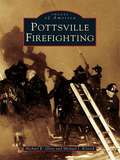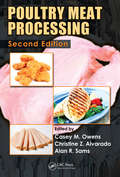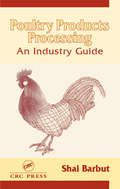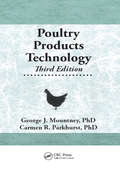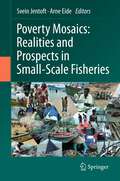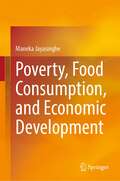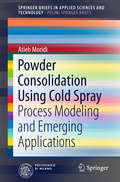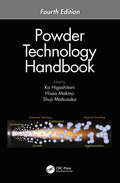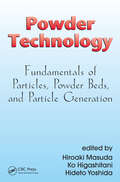- Table View
- List View
Potato Production Systems (Handbook Of Plant Breeding Ser. #13)
by Jeffrey C. Stark Mike Thornton Phillip NolteThis comprehensive guide to potato production systems management contains 20 chapters and more than 350 color photographs. Beginning with the history of potato culture, it spans all aspects of potato production, pest and planting management, storage, and marketing. Written by a team of over 35 scientists from North America, this book offers updated research-based information and serves as a unique, valuable tool for researchers, extension specialists, students, and farm managers. More than a description of principles, it contains practical analytical tools, charts, and methods to create guidelines for best production practices and cost estimates. Some key areas include: Potato Growth and Development, Potato Variety Selection and Management, Seed and Planting Management, Seed Production and Certification, Field Selection, Crop Rotation, and Soil Management, Integrated Pest Management for Potatoes, Potato Nutrient Management, Irrigation Management, Tuber Quality, Economics and Marketing, Production Costs, among others. Potato Production Systems should be a valuable reference for successful culture of the "noble tuber."
Potato Seed Production
by Sergey V. Zhevora Boris V. AnisimovThis book comprises the best potato seed production practices and includes details on potato cultivation, classification, and the main structural elements of the successive stages of potato seed production. It presents potato varieties from Russian originators, describes modern technologies involved in the process of potato seed production, and presents special aspects of phytosanitary and process regulations for the cultivation of high-quality potato seed.Additionally, the authors illustrate the statutory regulation of salable quality of potato seed: purity of variety, diseases, pests, and defects. The authors identify Russian quality control methods and certification of potato seed, and consider the packaging and labeling of potato seed that is held for sale. Finally, the authors also clarify the features of foreign potato seed certification systems.
Potato virus Y: biodiversity, pathogenicity, epidemiology and management
by Christophe Lacomme Laurent Glais Dirk U. Bellstedt Brice Dupuis Alexander V. Karasev Emmanuel JacquotPotato virus Y (PVY) infects a wide host range mainly within the Solanaceae and is distributed worldwide. PVY is transmitted by more than 40 aphid species in a non persistent manner. Isolates of the PVY species are highly variable at biological, serological and molecular levels. Epidemiological studies have highlighted the emergence of distinct potato PVY variants able to induce necroses on potato tubers. Due to the lack of efficient resistance to PVY isolates inducing necrotic symptoms in cultivated varieties and the plant-to-plant transmission of isolates through the daughter tubers, PVY has become the most economically important virus for the potato industry. The review offers an overview of several decades of research on PVY but also focuses on the latest data obtained by expert on PVY worldwide on the biological characteristics of PVY, interactions between aphids-hosts, its evolution and management. Identified knowledge gaps to understand further PVY biology will be discussed.
Potato: Botany Production And Uses
by Mark Taylor Roger Jones Howard Davies William Kirk Tim Waters Chuck Brown Wesley Everman Jennifer Bond Robert Robert Ian Burke Carrie Wohleb Albert Abbott Loretta Mikitzel Roy Navarre Kaiyun Xie Mark Stalham A Bussan Bjorn Kloosterman Paul Bethke David Wattie Richard Veilleux Rich Novy Roland van den Berg Mark Pavek Andy Jensen Vivian BlokPotatoes are a staple crop around the world. Covering all aspects of botany, production and uses, this book presents a comprehensive discussion of the most important topics for potato researchers and professionals. It assesses the latest research on plant growth such as tuber development, water use and seed production, covers all aspects of pest management and reviews postharvest issues such as storage, global markets, and of course, nutritional value and flavour.
Potato: Botany, Production and Uses (Botany, Production and Uses)
by Mark Taylor Roger Jones Howard Davies William Kirk Tim Waters Chuck Brown Wesley Everman Jennifer Bond Robert Robert Ian Burke Carrie Wohleb Albert Abbott Loretta Mikitzel Kaiyun Xie Mark Stalham A Bussan Bjorn Kloosterman Paul Bethke David Wattie Richard Veilleux Rich Novy Roland van den Berg Andy Jensen Vivian BlokPotatoes are a staple crop around the world. Covering all aspects of botany, production and uses, this book presents a comprehensive discussion of the most important topics for potato researchers and professionals. It assesses the latest research on plant growth such as tuber development, water use and seed production, covers all aspects of pest management and reviews postharvest issues such as storage, global markets, and of course, nutritional value and flavour.
Potato: Nutrition and Food Security (Compendium Of Plant Genomes Ser.)
by Swarup Kumar Chakrabarti Pinky Raigond Brajesh Singh Som DuttThis informative book focuses on the nutritional value of potatoes and ways to improve it. With the world reeling under the burden of an ever-growing population, there is a pressing need for affordable and nutritious staples to feed the billions. Potatoes are grown in a broad range of countries around the world and can substantially contribute to future food security. Given the increasing consumption of potatoes, there is a need for a book that compiles information on and raises awareness of their nutritional value, while also encouraging their consumption. The respective chapters of this book cover the chemical composition, structure and health benefits of potatoes, as well as genetic modifications used to alter the concentration of relevant chemical compounds in them. The book provides an overview of potatoes as a nutrient-dense crop, and discusses important aspects such as the role of potatoes in human diet, how they can improve the overall health of individuals, their role in addressing malnutrition etc. Its chapters deal with topics such as carbohydrates and glycemic index, dietary fibers, vitamins, proteins, phenols, carotenoids, anthocyanins, minerals, lipids, glycoalkaloids, new health-promoting compounds, the composition and utilization of potato peel, nutritional significance of potato products, and potato probiotics. Given its scope, the book will be of interest to undergraduate students, graduate students and researchers in plant physiology and biochemistry, plant genetic engineering, the food sciences and agriculture, as well as industry partners in related fields.
Potential Game Theory
by Quang Duy Lã Yong Huat Chew Boon-Hee SoongThis book offers a thorough examination of potential game theory and its applications in radio resource management for wireless communications systems and networking. The book addresses two major research goals: how to identify a given game as a potential game, and how to design the utility functions and the potential functions with certain special properties in order to formulate a potential game. After proposing a unifying mathematical framework for the identification of potential games, the text surveys existing applications of this technique within wireless communications and networking problems found in OFDMA 3G/4G/WiFi networks, as well as next-generation systems such as cognitive radios and dynamic spectrum access networks. Professionals interested in understanding the theoretical aspect of this specialized field will find Potential Game Theory a valuable resource, as will advanced-level engineering students. It paves the way for extensive and rigorous research exploration on a topic whose capacity for practical applications is vast but not yet fully exploited.
Potential Invasive Pests of Agricultural Crops
by Mark Hoddle V Satarkar Jose Carlos Rodrigues Crebio Avila J Alvarez Andrea Birke Jorge Peña Jose Roberto Parra Denise Navia Juliet Goldsmith Anne Roy Takumasa Kondo Kenneth Storey Aldo Malavasi Amy Roda J. Ramon Valiente Mark Culik Ana Isabel Gonzalez Michael Hennessey Jose Romeno Faleiro Greg Hodges Juli Gould Alvaro Castañeda Vildózola Gregory Evans Cal Welbourn David Bartels Alberto Urbaneja Ana Diaz Montilla Robert Haack Raymond GagneInvasive arthropods cause significant damage in agricultural crops and natural environments across the globe. Potentially threatened regions need to be prepared to prevent new pests from becoming established. Therefore, information on pest identity, host range, geographical distribution, biology, tools for detection and identification are all essential to researchers and regulatory personnel. This book focuses on the most recent invasive pests of agricultural crops in temperate subtropical and tropical areas and on potential invaders, discussing their spread, biology and control.
Potential Invasive Pests of Agricultural Crops
by Mark Hoddle V Satarkar Jose Carlos Rodrigues Crebio Avila J Alvarez Andrea Birke Jose Roberto Parra Denise Navia Juliet Goldsmith Anne Roy Takumasa Kondo Kenneth Storey Aldo Malavasi Amy Roda J. Ramon Valiente Mark Culik Ana Isabel Gonzalez Michael Hennessey Jose Romeno Faleiro Greg Hodges Juli Gould Alvaro Castañeda Vildózola Gregory Evans Cal Welbourn David Bartels Alberto Urbaneja Ana Diaz Montilla Robert Haack Raymond GagneInvasive arthropods cause significant damage in agricultural crops and natural environments across the globe. Potentially threatened regions need to be prepared to prevent new pests from becoming established. Therefore, information on pest identity, host range, geographical distribution, biology, tools for detection and identification are all essential to researchers and regulatory personnel. This book focuses on the most recent invasive pests of agricultural crops in temperate subtropical and tropical areas and on potential invaders, discussing their spread, biology and control.
Potential Pulses: Genetic and Genomic Resources
by Parul Sharma Amit Kumar Singh Olubukola Oluranti Babalola Dr Mithlesh Kumar Daniel B. Adewale Dr Michael Abberton Gopal Katna Kanishka Chandora Martial Nounagnon Gautier Roko Nadège Adoukè Agbodjato Durand Dah-Nouvlessounon Lamine Baba-Moussa Kirti Rani Shailesh Kumar Jain Moti Lal Mehriya Dr Gayacharan Swarup K. Parida Debashish Chattopadhyay D. C. Joshi P. S. Basavaraj Ramya Rathod Krishna Kumar Jangid K. M. Boraiah C. B. Harisha H. M. Halli Kuldeep Tripathi K. Sammi Reddy Carine Nono Temegne Isabel Milagros Figari Esaïe Tsoata Paul Agendia Francis Ajebesone Ngome Anupam Tripathi S. Gurumurthy C. Mahadevaiah DevindrappaThe fight against global hunger demands a fresh perspective. Lesser-known legumes, often called 'potential pulses', can play a pivotal role. These underutilized powerhouses, including adzuki bean, bambara groundnut, faba bean, cowpea, grass pea and horse gram, among others, are currently untapped resources. Their potential goes beyond their ability to thrive in harsh environments (caused by high temperature, drought, etc.) and fix nitrogen. With increased understanding of these legumes and their genetic and genomic potential, we can unlock a new world of sustainable and nutritious food sources. This book explores: The rich genetic diversity of potential pulses and its role in resilience. How advanced genomics can identify traits for improved yields, pest resistance, and climate adaptation. Strategies for conserving and utilizing these valuable genetic resources. Breeding programmes harnessing genetic potential to create next-generation pulse varieties. Focusing on the untapped genetic and genomic potential of these legumes, this book empowers researchers, breeders, and policymakers to unlock a new era of food and nutritional security. By leveraging the power of their genes, we can transform underutilized pulses into the nutritional heroes of tomorrow.
Potential Radiation Exposure in Military Operations: Protecting the Soldier Before, During, and After
by Institute of MedicineThe Committee's final report, reiterating technical aspects addressed in a 1997 interim report, and putting the research findings in an ethical context. The report focuses on the potential exposure of military personnel to radiation doses up to 700 millisievert, examining dosimetry, radiation physics, and the medical follow-up of potential subsequent tumor development. There is no index. Annotation c. Book News, Inc. , Portland, OR (booknews. com)
Potential Therapeutic Applications of Nano-antioxidants
by Ashutosh Kumar Shukla Sharda Sundaram SanjayThis book highlights the nano-antioxidants and their potential therapeutic applications. The chapters start with basic information on free radicals and antioxidants, through natural antioxidants, mechanisms of their action, ending with the use of nano-antioxidants particularly its potential therapeutic applications. Nano-antioxidant therapy has a promising future that has to be explored. It is a bridge topic to connect the already existing literature with potential therapeutic highlights. This book is designated for students and researchers interested in Biochemistry, Chemistry, Physics, Food Science and nutrition, Pharmaceutical Science and Medicine. It would also be interesting to global audiences from human and animal nutrition to food preservation and packaging.
Potential Yields of Major Crops for Chinese and Global Food Security Under Climate Change
by Chengzhi Cai Wenfang CaoThis book analyzes potential yields of six major food crops - rice, wheat, maize, potato, soybean and rapeseed worldwide using both qualitative and quantitative approaches to study both China’s and global food security under climate change. Firstly, it reviews previous studies on potential yields of rice, wheat, maize, potato, soybean and rapeseed worldwide to provide a detailed information of studying on China’s and global food security based on the product’s supply and demand of these crops. Secondly, average and top (national) yields of rice, wheat, maize, potato, soybean and rapeseed since 1961 on global scale are employed to analyze their temporal and spatial variation trends and potential limits. Thirdly, the effects of global warming in climate change on both average and top yields of rice, wheat, maize, potato, soybean and rapeseed since 1961 at global level are analyzed using regression model, and their differences between average and top yields among these crops are identified and compared. Fourthly, the yields and per capita quantity of rice, wheat, maize, potato, soybean and rapeseed in major producer-countries and the world are analyzed to assess the situation and trend of international trade for the products of these crops, respectively.Fifthly, potential yields of rice, wheat, maize, potato, soybean and rapeseed worldwide by 2030 are projected using both trend-regressed models and ARIMA models to estimate the per capita quantity of these crops based on the projection of world population and assess the status of Chinese and global food security in that future. Finally, it provides policy implications and advice on food security for China and the world directing food production by 2030 under climate change.
Potential and Challenges of Low Carbon Fuels for Sustainable Transport (Energy, Environment, and Sustainability)
by Avinash Kumar Agarwal Hardikk ValeraThis book focuses on low carbon fuels a preferable class of fuels for Internal Combustion Engines (ICEs) highlighting the effect of low carbon fuels on tailpipe emissions. This book aims to strengthen the knowledge base dealing with low carbon fuels as a sustainable transport fuel. The volume includes recent results and are focused on current trends of automotive sector. This book will be of interest to those in academia and industry involved in fuels, IC engines, engine instrumentation, and environmental research.
Potential of Low-Medium Enthalpy Geothermal Energy: Hybridization and Application in Industry (Green Energy and Technology)
by Antonio Colmenar-Santos Enrique Rosales-Asensio Elisabet PalomoThis book highlights the importance of geothermal energy by studying its potential either alone or in combination with solar energy, focusing on its industrial application. Its starting point is to identify in a thorough and precise manner the barriers that hinder the implementation of geothermal energy in Spain and the European Union and the measures to be taken to achieve its diffusion and regular use. Next, the book looks at how geothermal energy could contribute to this sector and to the desalination industry in particular, analysing a specific case in the south of Spain and extrapolating its results to a set of existing desalination plants in the Spanish Mediterranean with really interesting results in terms of economic amortisation and CO2 emissions avoided to the atmosphere. Beyond the desalination industry, this work demonstrates that almost 85% of the industrial processes of all industry in Spain can be carried out with very low, low and medium temperature geothermal resources and even applies its results to a set of existing solar plants, comparing in economic terms the results already obtained with those that would have been obtained if geothermal energy had been applied.
Pottsville Firefighting (Images of America)
by Michael R. Glore Michael J. KitsockIn 1829, the Humane Hose Company and the Schuylkill Hydraulians Engine Company organized in the booming town of Pottsville, a mining center in Pennsylvania's anthracite coal region. Fire protection was urgently needed for this growing community. New fire companies such as the Good Intent, the Rough and Ready, and the Good Will formed, as well as junior fire companies, including the Rangers and the Young America. In a patriotic response to President Lincoln's call to arms, two Pottsville fire companies disbanded, committing themselves to the Union; they became members of the legendary "First Defenders" of the Civil War. The twentieth century brought new challenges of motorization, dieselization, and ever-stricter training standards. Pottsville Firefighting celebrates one hundred seventy-five years of firefighting in Pottsville.
Poultry Breeds: Chickens, Ducks, Geese, Turkeys: The Pocket Guide to 104 Essential Breeds
by Carol EkariusPoultry Breeds is a fresh field guide of feathered friends with stunning photos highlighting the beauty and unique attributes of 104 chicken, duck, goose, and turkey breeds. Each profile outlines the bird’s history, physical characteristics, and common uses, with specially noted fun facts sprinkled throughout. This pocket-size, browsable guide is easy to use, and author Carol Ekarius knows her birds: she has been writing about livestock for nearly 20 years and has raised her own for decades.
Poultry Meat Processing (South America, Central America and the Caribbean)
by Casey M. OwensWhen the first edition of Poultry Meat Processing was published, it provided a complete presentation of the theoretical and practical aspects of poultry meat processing, exploring the complex mix of biology, chemistry, engineering, marketing, and economics involved. Upholding its reputation as the most comprehensive text available, Poultry Meat Pro
Poultry Products Processing: An Industry Guide
by Shai BarbutPoultry Products Processing: An Industry Guide covers all major aspects of the modern poultry further processing industry. The author provides a comprehensive guide to the many steps involved in converting poultry muscle (chicken, turkey, duck, ratite, etc.) into meat and highlights the critical points required to assure high quality and safe produ
Poultry Products Technology: Third Edition
by VivianE MountneyNow in its third edition, this classic volume characterizes the science and technology of the poultry industry today, defines the breadth and scope of the overall problems in the industry, and points out areas where more research is needed. With special attention to recent changes in the industry, the nearly two dozen updated chapters of Poultry Products Technology provide a comprehensive overview of the field, examining topics which deal with the processing, handling, marketing, and preparation of poultry meat, products, and by-products.Poultry Products Technology provides up-to-date information and references for food scientists, food technologists, dieticians, and others trained in the food service industry, who will at some point handle poultry products. This book supplies knowledge about how poultry and eggs are processed and prepared and how they can be used for optimum portions and services. The breadth of topics covered, as listed below, make it an ideal text for those just entering the field, for individuals who wish to learn about the work in a particular area before starting extensive research, and for those in the industry who require specific information for making decisions and projecting plans for the future:quality identification--grades and standardsquality maintenance--handling and processing poultry and eggs to prevent grade losseschemical and nutritive characteristics of poultry meat and eggsmicrobiology of eggs and poultry meatmethods of preservation--freezing, drying, refrigeration, radiation, canning, smokingcooking poultry meat and eggshandling and uses of inedible by-productsmethods of analysis of eggs and egg productsDuring the last twenty years, the consumption of poultry meat has and continues to increase while the consumption of eggs has steadily decreased, yet both are still considered good econ
Poverty Mosaics: Realities and Prospects in Small-Scale Fisheries
by Svein Jentoft Arne EideSmall-scale fisheries are a major source of food and employment around the world. Yet, many small-scale fishers work in conditions that are neither safe nor secure. Millions of them are poor, and often they are socially and politically marginalized. Macro-economic and institutional mechanisms are essential to address these poverty and vulnerability problems; however, interventions at the local community level are also necessary. This requires deep understanding of what poverty means to the fishers, their families and communities; how they cope with it; and the challenges they face to increase resiliency and improve their lives for the better. This book provides a global perspective, situating small-scale fisheries within the broad academic discourse on poverty, fisheries management and development. In-depth case studies from fifteen countries in Latin America, Europe, South and Southeast Asia, and sub-Saharan Africa, demonstrate the enormously complex ecological, economic, social, cultural and political contexts of this sector. Conclusions for policy-making, formulated as a joint statement by the authors, argue that fisheries development, poverty alleviation, and resource management must be integrated within a comprehensive governance approach that also looks beyond fisheries. The scientific editors, Svein Jentoft and Arne Eide, are both with the Norwegian College of Fishery Science, Faculty of Biosciences, Fisheries and Economics, University of Tromsø, Norway.
Poverty, Food Consumption, and Economic Development
by Maneka JayasingheThis book investigates the relationships between economies of scale in food consumption and a number of socio-economic and demographic characteristics of households and household behavioural choices since food is the major share of household expenditure for poor households. The characteristics considered comprise household size, location, income, and gender of the head of household while the behavioural choices considered comprise the decision to consume home-grown food and the decision to adopt domestic technology to aid food preparation and consumption. The book proposes two theoretical models to rationalize the role of the consumption of home-grown food and the adoption of domestic technology in enhancing economies of scale in food consumption. Econometric models are also used to empirically test the validity of the two theoretical models while adjusted poverty estimations are derived numerically using the estimated equivalence scales. Although data used in applying these techniques are based on four Household Income and Expenditure Surveys conducted by the Department of Census and Statistics (DCS) in Sri Lanka, the methodology can be used for similar analysis in relation to any other country.
Powder Consolidation Using Cold Spray
by Atieh MoridiThis book first presents different approaches to modeling of the cold spray process with the aim of extending current understanding of its fundamental principles and then describes emerging applications of cold spray. In the coverage of modeling, careful attention is devoted to the assessment of critical and erosion velocities. In order to reveal the phenomenological characteristics of interface bonding, severe, localized plastic deformation and material jet formation are studied. Detailed consideration is also given to the effect of macroscopic defects such as interparticle boundaries and subsequent splat boundary cracking on the mechanical behavior of cold spray coatings. The discussion of applications focuses in particular on the repair of damaged parts and additive manufacturing in various disciplines from aerospace to biomedical engineering. Key aspects include a systematic study of defect shape and the ability of cold spray to fill the defect, examination of the fatigue behavior of coatings for structural applications, and a novel working window at subcritical conditions to obtain porous structures. This book is exceptional in scope, and its review of finite element modelling at different length scales sheds light on future design and process improvement in emerging applications such as structural repair, metal additive manufacturing and metal foam design.
Powder Technology Handbook
by Ko Higashitani Hisao Makino Shuji MatsusakaThe Fourth Edition of Powder Technology Handbook continues to serve as the comprehensive guide to powder technology and the fundamental engineering processes of particulate technology, while incorporating significant advances in the field in the decade since publication of the previous edition. The handbook offers a well-rounded perspective on powder technologies in gas and liquid phases that extends from particles and powders to powder beds and from basic problems to actual applications. This new edition features fully updated and new chapters written by a team of internationally distinguished contributors. All content has been updated and new sections added on. Powder Technology Handbook provides methodologies of powder and particle handling technology essential to scientific researchers and practical industrial engineers. It contains contemporary and comprehensive information on powder and particle handling technology that is extremely useful not only to newcomers but also to experienced engineers and researchers in the field of powder and particle science and technology.
Powder Technology: Fundamentals of Particles, Powder Beds, and Particle Generation
by Ko Higashitani Hiroaki Masuda Hideto YoshidaDrawing from the third edition of the bestselling Powder Technology Handbook, this book is focused solely on analyzing the fundamental properties and behavior of particles and particle beds. Powder Technology:Fundamentals of Particles, Powder Beds, and Particle Generation concentrates on the most useful analytical methods of o
